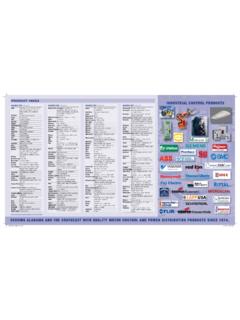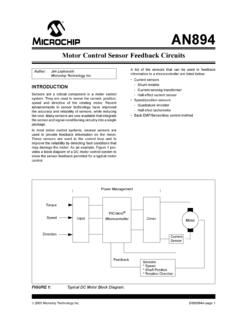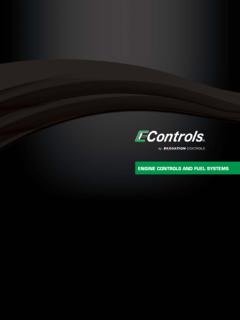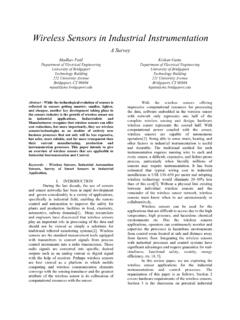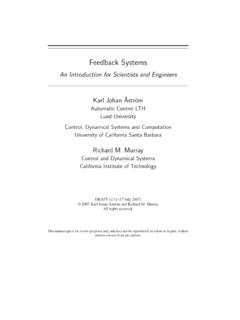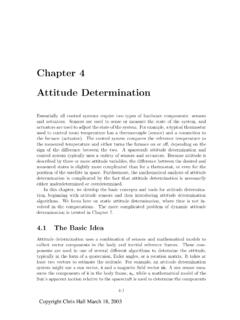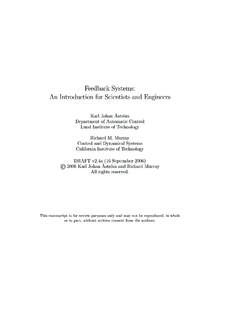Transcription of Advanced Sensors, Control, Platforms, and …
1 DRAFT PRE-DECISIONAL DRAFT 1 Advanced Sensors, control , Platforms, and Modeling 1 for Manufacturing (Smart Manufacturing): 2 Technology Assessment 3 Contents 4 1. Introduction to the Technology/ system .. 2 5 Overview .. 2 6 Challenges and opportunities .. 2 7 Public and private roles and activities .. 3 8 2. Technology Assessment and Potential .. 3 9 Performance advances .. 3 10 Technology and system Integration Needs for Improvement .. 6 11 Open standards and interoperability for manufacturing devices, systems, and services .. 6 12 Real-time measurement, monitoring and optimization solutions of machine energy 13 consumption and waste streams.
2 6 14 Energy optimization of processes and integration with smart grids, cogeneration, and 15 microgrids .. 6 16 Health management for manufacturing equipment and systems .. 6 17 Low-power, resilient wireless sensors and sensor networks .. 7 18 Integration with Big Data Analytics and Digital Thread .. 7 19 platform infrastructure for integration and orchestration of public and private data and 20 software across heterogeneous and human systems .. 7 21 Software-service oriented platforms for manufacturing automation .. 7 22 Theory and algorithms for model-based control and optimization in the manufacturing 23 domain 7 24 Modeling and simulation at temporal and spatial scales relevant across manufacturing.
3 8 25 Potential Impacts: .. 8 26 3. Program Considerations to Support R&D .. 9 27 4. Risk and Uncertainty, and Other Considerations .. 11 28 5. Sidebars and Case 11 29 Case Studies .. 11 30 Sidebar: Superior Energy Performance and Smart Manufacturing .. 12 31 References .. 14 32 DRAFT PRE-DECISIONAL DRAFT 2 33 1. Introduction to the Technology/ system 34 Overview 35 Advanced manufacturing technology is rapidly transforming the global competitive landscape. 36 Incremental technology upgrades alone may no longer be sufficient for companies to be competitive in 37 the 21st century.
4 Advanced Sensors, control , Platforms, and Modeling for Manufacturing (ASCPMM) 38 will help address this need by enabling cross connection of diverse data, process control applications, 39 and decision workflows using Advanced sensors and a network-based, open architecture, plug-and-play 40 platform . The ASCPMM topic, also known as Smart Manufacturing, represents an emerging opportunity 41 faced broadly by the manufacturing sector. ASCPMM encompasses machine-to-plant-to-enterprise-42 to-supply-chain aspects of sensing, instrumentation, 43 monitoring, control , and optimization as well as hardware and 44 software platforms for industrial automation.
5 Advanced 45 sensors, processors, and communication networks are used 46 to improve manufacturing efficiency through the real-time 47 management of energy, productivity and costs at the level of 48 the factory and enterprise. A holistic systems approach, from 49 raw materials to end-user services, is used to identify 50 manufacturing pathways that optimize production rates that 51 meet consumer demands while minimizing excess production 52 at each manufacturing step1. Smart manufacturing is related 53 to intelligent efficiency, as they both use Information 54 Communication Technology (ICT) to achieve efficiency goals.
6 55 Intelligent efficiency is energy efficiency achieved through 56 sensor , control , and communication technologies, while 57 smart manufacturing has a larger enterprise efficiency 58 purpose with energy efficiency being a co-benefit to the 59 improvements. Figure 1 shows the relationship between 60 smart manufacturing, intelligent efficiency, ICT, and the 61 Internet of Things. It is estimated that investments in smart 62 manufacturing could generate cost savings and new revenues 63 that could add $10 15 trillion to global gross domestic 64 product (GDP) over the next 20 years2.
7 Over that period, the 65 manufacturing sector could realize savings of $15 billion in 66 annual electricity costs savings with average company energy demand reducing by 20%3. 67 68 Challenges and opportunities 69 While aspects of ASCPMM have been successfully implemented in several key discrete industries, 70 challenges remain in implementing ASCPMM more broadly throughout manufacturing. Key challenges 71 to implementation include traditional capital investment, the type of manufacturing process, and the 72 process environment, such as: 73 Figure 1. Relationship of ICT, Internet of Things, intelligent efficiency, and smart manufacturing from Rogers, Subsets of ICT include; intelligent efficiency: energy savings resulting from ICT-enabled connection of sensors, devices, systems, facilities, and users; smart manufacturing: superior productivity resulting from the integration of all aspects of manufacturing; Internet of Things: machine-to-machines interaction through the Internet.
8 DRAFT PRE-DECISIONAL DRAFT 3 The turnover rate of capital assets can be very slow. In many manufacturing facilities, process 74 equipment, such as the blast furnace and distributed control systems, is used for many decades 75 before they are retired or replaced; as a result, technology advancements are often evolutionary 76 rather than revolutionary. 77 Incremental investments in process control and IT are viewed as optional and non-critical with 78 high cost factors. The value is low when implemented incrementally and in a compartmentalized 79 manner, resulting in perceived low value.
9 This imposes a cost barrier for ASCPMM. 80 Energy-intensive industries, while relatively Advanced , often rely on continuous production 81 where materials being processed, either dry bulk or fluids, are continuously in motion, 82 undergoing chemical reactions or subject to mechanical or heat treatment. These plants 83 typically operate 24 hours per day, seven days a week with infrequent maintenance shutdowns, 84 such as semi-annual or annual. Some chemical plants operate for more than two years without a 85 shutdown. Blast furnaces can run four to ten years without stopping for a major 86 Technological advances in sensing and control may have to endure high temperature, high-87 pressure, and/or harsh environments.
10 For example, a sensor used to monitor ultra-supercritical 88 boilers must withstand a temperature of over 700 C and pressure of 5000 PSI. A gasifier 89 environment not only has similar high temperature and pressure, but also corrosion and 90 erosion. Instrumentation and sensors used in ASCPMM today may not be suitable for certain 91 process conditions. These sensors must also be affordable, able to extract more sophisticated 92 data, and ideally be able to transmit wirelessly in real-time. 93 94 Public and private roles and activities 95 ASCPMM was specifically called out in the White House Advanced Manufacturing Partnership (AMP) 96 Steering Committee as one of three highest priority Advanced manufacturing technology areas in need 97 of federal Individual industry players are not likely to individually address the key 98 foundational challenges that need to be overcome for widespread adoption such as technology 99 integration and open, interoperable platforms.










